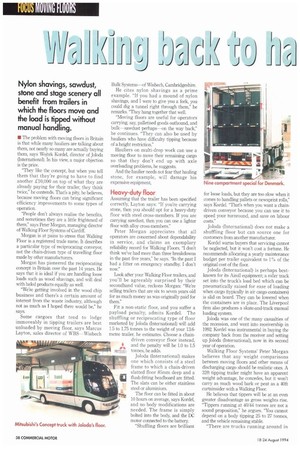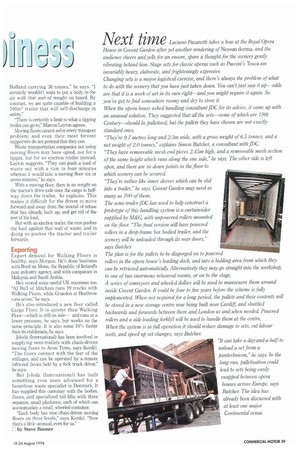Nylon shavings, sawdust, stone and stage scenery all benefit from
Page 40

Page 41

If you've noticed an error in this article please click here to report it so we can fix it.
trailers in which the floors move and the load is tipped without manual handling.
• The problem with moving floors in Britain is that while many hauliers are talking about them, not nearly so many are actually buying them, says Wojtek Kordel, director of Joloda (International). In his view, a major objection is the price.
"They like the concept, but when you tell them that they're going to have to find another £10,000 on top of what they are already paying for their trailer, they think twice," he contends. That's a pity he believes, because moving floors can bring significant efficiency improvements to some types of Operation.
"People don't always realise the benefits, and sometimes they are a little frightened of them," says Peter Morgan, managing director of Walking Floor Systems of Cardiff.
Morgan is at pains to stress that Walking Floor is a registered trade name. It describes a particular type of reciprocating conveyor, not the chain-driven type of travelling floor made by other manufacturers.
Morgan has pioneered the reciprocating concept in Britain over the past 14 years. He says that it is ideal if you are handling loose loads such as wood shavings, and will deal with baled products equally as well.
"We're getting involved in the wood chip business and there's a certain amount of interest from the waste industry, although not as much as I hoped there would be," he says.
Some cargoes that tend to lodge immoveably in tipping trailers are best unloaded by moving floor, says Marcus Layton, sales director of WBS—Wisbech Bulk Systems--of Wisbech, Cambridgeshire.
He cites nylon shavings as a prime example. "If you had a mound of nylon shavings, and I were to give you a fork, you could dig a tunnel right through them," he remarks. "They hang together that well.
"Moving floors are useful for operators carrying, say, palletised goods outbound, and bulk—sawdust perhaps—on the way back," he continues. "They can also be used by hauliers who have difficulty tipping because of a height restriction."
Hauliers on multi-drop work can use a moving floor to move their remaining cargo so that they don't end up with axle overloading problems, he suggests And the haulier needs not fear that hauling stone, for example, will damage his expensive equipment,
Heavy-duty floor
Assuming that the trailer has been specified correctly, Layton says: "If you're carrying stone, then you should opt for a heavy-duty floor with steel cross-members. If you are carrying sawdust, then you can use a lighter floor with alloy cross members."
Peter Morgan appreciates that all operators are concerned about dependability in service, and claims an exemplary reliability record for Walking Floors. "I don't think we've had more than three breakdowns in the past five years," he says. "In the past I had a fitter on emergency standby. I don't now."
Look after your Walking Floor trailers, and you'll be agreeably surprised by their secondhand value, reckons Morgan: "We're selling trailers that are six to seven years old for as much money as was originally paid for them."
Fit a non-static floor, and you suffer a payload penalty, admits Kordel. The shuffling or reciprocating type of floor marketed by Joloda (International) will add 1.5 to 1.75 tonnes to the weight of your 13.6metre trailer, he estimates. Choose a chaindriven conveyor floor instead, and the penalty will be 1.0 to 1.5 tonnes, he adds.
Joloda (International) makes one which consists of a steel frame to which a chain-driven slatted floor 85mm deep and a flush-fitting headboard are fitted. The slats can be either stainless steel or aluminium.
The floor can be fitted in about 10 hours on average, says Kordel, and no body modifications are needed. The frame is simply bolted into the body, and the DC motor connected to the battery "Shuffling floors are brilliant for loose loads, but they are too slow when it comes to handling pallets or newsprint rolls," says Kordel. "That's when you want a chaindriven conveyor because you can use it to speed your turnround, and save on labour costs" Joloda (International) does not make a shuffling floor but can source one for customers from another manufacturer.
Kordel warns buyers that servicing cannot be neglected, but it won't cost a fortune. He recommends allocating a yearly maintenance budget per trailer equivalent to 1% of the original cost of the floor.
Joloda (International) is perhaps bestknown for its Airoll equipment; a roller track set into the truck's load bed which can be pneumatically raised for ease of loading when cargo (typically in air cargo containers) is slid on board. They can be lowered when the containers are in place. The Liverpool firm also produces a skate-and-track manual loading system.
Joloda was one of the many casualties of the recession, and went into receivership in 1992. Kordel was instrumental in buying the company back from the receiver and setting up Joloda (International), now in its second year of operation.
Walking Floor Systems' Peter Morgan believes that any weight comparisons between moving floors and other means of discharging cargo should be realistic ones. A 32ft tipping trailer might have an apparent weight advantage, he concedes, but it won't carry as much wood bark or peat as a 40ft curtainsider with a Walking Floor.
He believes that tippers will be at an even greater disadvantage as gross weights rise. "Tippers running at 40/44 tonnes are not a sound proposition," he argues. "You cannot depend on a body tipping 25 to 27 tonnes, and the vehicle remaining stable.
"There are trucks running around in
Holland carrying 36 tonnes," he says. "I certainly wouldn't want to put a body in the air with that sort of weight on board. By contrast, we are quite capable of building a 100m3 trailer that will self-discharge in safety"
"There is certainly a limit to what a tipping trailer can go to," Marcus Layton agrees.
Moving floors cannot solve every transport problem; and even their most fervent supporters do not pretend that they can.
Waste transportation companies not using moving floors may have opted, not for a tipper, but for an ejection trailer instead, Layton suggests. "They can push a load of waste out with a ram in four minutes whereas it would take a moving floor six or seven minutes," he says.
With a moving floor, there is no weight on the tractor's drive axle once the cargo is halfway down the trailer, he explains. This makes it difficult for the driver to move forward and away from the mound of refuse that has already built up, and get rid of the rest of his load.
But with an ejection trailer, the ram pushes the load against that wall of waste, and in doing so pushes the tractor and trailer forwards.
Exporting
Export demand for Walking Floors is healthy, says Morgan. Ile's done business with Bord na Mona, the Republic of Ireland's peat industry agency, and with companies in Malaysia and Saudi Arabia.
He's scored some useful UK successes too. "AJ Bull of Mitcham runs 19 trucks with Walking Floors, while Grundon at Heathrow runs seven," he says.
He's also introduced a new floor called Cargo Floor. It is quieter than Walking Floor—which is still on sale— and runs at a lower pressure, he says, but works on the same principle. It is also some 10% faster than its stablemate, he says.
Joloda (International) has been involved in supplying semi-trailers with chain-driven moving floors to Avon Tyres, says Kordel. "The floors connect with the feet of the stillages, and can be operated by a remote infra-red device held by a fork truck driver." he says.
But Joloda (International) has built something even more advanced for a hazardous waste specialist in Denmark. It has supplied this customer with the bodies. floors, and specialised tail-lifts with three separate, small platforms, each of which can accommodate a small, wheeled container.
"Each body has nine chain-driven moving floors on three levels," says Kordel. "Now that's a little unusual, even for us."
E by Steve Banner
























































































